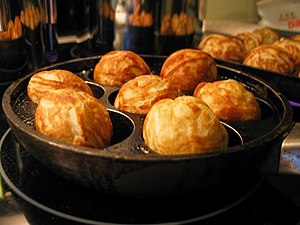
I am somewhat conflicted regarding my Scandinavian heritage. My mother was adopted into a Danish familyand was reared with proud Danish tradi
tions. After she died, I discovered her biological roots were Norwegian. This fact, combined with my brother-in-law having Norwegian roots and being an excellent cook/baker, has brought me to thinking Norwegian over Danish in my later years. But still, all my early Christmas traditions center around Danish memories. And the one tradition that I insist is better in Danish form than Norwegian is that of the Danish donuts known as Klejner (pronounced klein-er) over Fattigman (futty-mun?)
This is the sort of recipe that demands participation. In other words, don't try this alone. Better yet, have someone present that has done it before or at least witnessed the process. Be prepared to have a lot of cookies when you're done even though the dough might look small. I have erred by doubling the batch and believe me, it was a long night frying dough.
One last attempt to dissuade anyone from making these: the clean-up is horrendous. The more frying pans you have, the faster it will go but the more to clean. Without further ado, here is one last recipe handed down by my mother from her (Danish) mother:
Klejner (Danish Donuts but really fried cookies)
3 eggs
1 cup sugar
1/2 tsp salt
4 tbsp cream
1/2 cup MELTED butter
1 tsp baking powder
3-4 cups flour
1 tsp vanilla or cardamon (I've only ever had them with cardamon)
Beat eggs and sugar together, add cream, melted butter, and then dry ingredients.
Add enough flour to make a still dough. Chill for easier handling. (Impossible to handle if not chilled.)
Take about an orange-sized gob of dough (err on the less rather than more) and place on a floured surface. Roll flat. With a pastry wheel (or pizza cutter), cut diagonal lines resulting in diamond shapes (or pointed rectangles as my original recipe says.) Make a small slit down the center of each shape.
The picture to the right is pretty accurate except for the extra margin of dough cut out between the individual cookies. I've never done that.
Shape the klejner -- easier to show than describe. My mother's recipe simply says "turn through the middle." It really is easy, but work gently. Pull the center open slightly, then bend the top point back
and pull it through the middle toward you. I hope the picture helps explain this.
My recipe also lacks detailed frying instructions other than to say it takes about a pound and a half of shortening, although a larger fry pan might need 2 pounds. The melted shortening should be deep though and test by dropping a very small amount of dough. If it sizzles and starts browning, that should be right for cooking the batch.
Fry about six at a time, too many will cool the oil and ruin the batch. When light golden on the oil side, flip over and brown the other side. Meanwhile, your cooking companion(s) can be busy rolling out another batch. Drain on toweling after removing from the oil.
Continue working batches until most of the dough is gone. We always save scraps and reroll for more, but you can also cut into other shapes.
Luckily for today's cooks, there is the Internet. You can find You-Tube videos demonstrating the entire process which I recommend for complete novices. After looking at several online recipes, I see slight differences in amounts and ingredients. My family recipe results in a donut-like texture although crunchy rather than soft. The results are more raised than some of the flatter ones I've encountered.
Should I ever have enough ambition to tackle these again, I might try a bit of lemon zest to punch up the flavor. They can tend toward the bland side so using fresh grated cardamon instead of powdered might give them more zip too.
Store them in tins lined with wax paper or paper towels. They actually last a long time but you could try freezing (probably come out soggy when thawed).
This is my last entry about my Christmas cooking traditions. Thank you for reading and may you enjoy the holiday season whatever way you celebrate.
